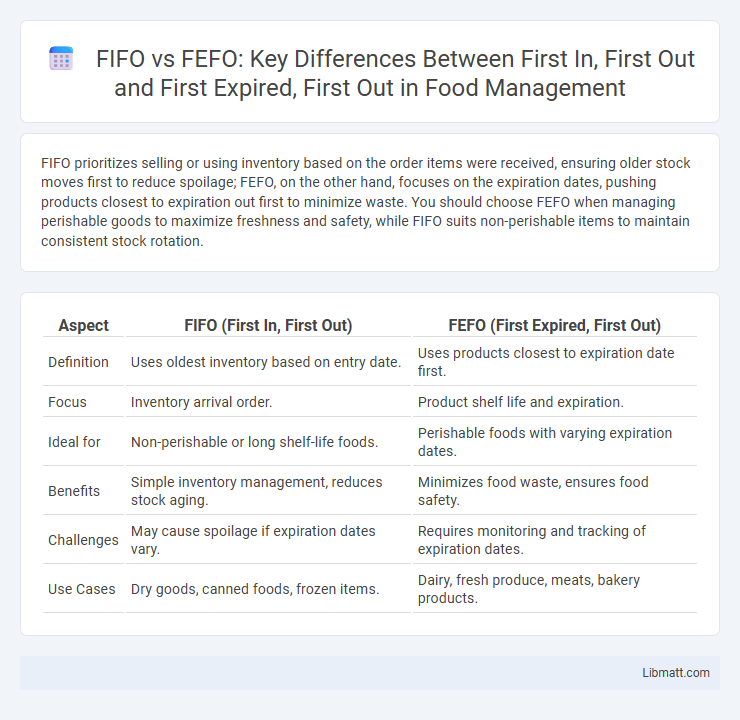FIFO prioritizes selling or using inventory based on the order items were received, ensuring older stock moves first to reduce spoilage; FEFO, on the other hand, focuses on the expiration dates, pushing products closest to expiration out first to minimize waste. You should choose FEFO when managing perishable goods to maximize freshness and safety, while FIFO suits non-perishable items to maintain consistent stock rotation.
Table of Comparison
| Aspect | FIFO (First In, First Out) | FEFO (First Expired, First Out) |
|---|---|---|
| Definition | Uses oldest inventory based on entry date. | Uses products closest to expiration date first. |
| Focus | Inventory arrival order. | Product shelf life and expiration. |
| Ideal for | Non-perishable or long shelf-life foods. | Perishable foods with varying expiration dates. |
| Benefits | Simple inventory management, reduces stock aging. | Minimizes food waste, ensures food safety. |
| Challenges | May cause spoilage if expiration dates vary. | Requires monitoring and tracking of expiration dates. |
| Use Cases | Dry goods, canned foods, frozen items. | Dairy, fresh produce, meats, bakery products. |
Introduction to Inventory Management Methods
FIFO and FEFO are essential inventory management methods that optimize stock rotation based on different criteria. FIFO (First In, First Out) prioritizes selling older inventory first to reduce holding costs and avoid obsolescence, making it ideal for non-perishable goods. FEFO (First Expired, First Out) emphasizes selling products nearing expiration first, ensuring freshness and reducing waste, which is crucial for perishable items like food and pharmaceuticals.
What is FIFO (First In, First Out)?
FIFO (First In, First Out) is an inventory management method where the oldest stock is sold or used before newer items to minimize spoilage and obsolescence. This system is widely implemented in industries such as food, pharmaceuticals, and retail to ensure product freshness and regulatory compliance. FIFO helps maintain accurate stock rotation, reduces waste, and improves financial accounting by aligning cost flow with actual inventory usage.
What is FEFO (First Expired, First Out)?
FEFO (First Expired, First Out) is an inventory management method that prioritizes the use or sale of products based on their expiration dates, ensuring items closest to expiry are dispatched first. This system reduces waste and spoilage by minimizing the risk of expired goods remaining in stock. FEFO is particularly essential in industries like food, pharmaceuticals, and cosmetics where product shelf life is critical.
Key Differences Between FIFO and FEFO
FIFO (First In, First Out) prioritizes the oldest inventory based on arrival time, ensuring that products received earliest are sold or used first, reducing the risk of stock obsolescence. FEFO (First Expired, First Out) prioritizes inventory based on expiration dates, ensuring products closest to their expiry are utilized first to minimize waste and spoilage. Understanding these key differences helps optimize inventory management depending on whether time of arrival or product shelf life drives your operational priorities.
Advantages of Using FIFO
FIFO prioritizes the use of older inventory first, reducing the risk of products becoming obsolete or expiring, which is critical for perishable goods and maintaining product quality. This method improves inventory turnover rates, leading to more accurate financial reporting and minimizing holding costs. Businesses adopting FIFO benefit from enhanced stock management, ensuring first purchased items are sold before newer inventory, ultimately optimizing cash flow.
Benefits of Applying FEFO
Applying FEFO ensures your inventory moves efficiently by prioritizing products with the nearest expiration dates, significantly reducing waste and spoilage. This method enhances product quality for customers by guaranteeing fresher goods and helps maintain compliance with safety regulations. Businesses benefit from improved stock management and cost savings by minimizing losses associated with expired items.
Industry Applications: When to Use FIFO or FEFO
FIFO is ideal for industries dealing with non-perishable goods or products where inventory turns based on arrival time, such as electronics or automotive parts, ensuring older stock is sold before newer stock. FEFO finds primary use in food, pharmaceuticals, and chemicals industries where product expiration dates critically impact safety and compliance, prioritizing the dispatch of products that expire soonest. Choosing between FIFO and FEFO depends on inventory nature, regulatory requirements, and the risk of product obsolescence or spoilage.
Challenges and Limitations of FIFO and FEFO
FIFO faces challenges in managing perishable goods where expiration dates vary, potentially leading to waste despite chronological order usage. FEFO requires detailed tracking systems and accurate expiration date data to implement effectively, posing operational complexity and higher costs. Both systems struggle with inventory inaccuracies and demand rigorous monitoring to minimize spoilage and financial loss.
Technology and Tools for FIFO and FEFO Implementation
Technology such as inventory management software and RFID systems enhances the accuracy and efficiency of FIFO and FEFO implementation by automatically tracking product arrival dates and expiration timelines. Barcode scanning tools and IoT sensors provide real-time data to ensure Your inventory moves according to the correct method, reducing waste and optimizing stock rotation. Cloud-based platforms offer centralized control and analytics, enabling seamless integration of FIFO and FEFO processes within supply chain operations.
Choosing the Best Inventory Strategy for Your Business
Choosing the best inventory strategy for your business depends on product type and shelf life considerations. FIFO (First In, First Out) ensures older stock is sold first, minimizing spoilage for non-perishable goods, while FEFO (First Expired, First Out) prioritizes items closest to expiration, crucial for perishable products like food, pharmaceuticals, and cosmetics. Understanding your product's storage requirements and turnover rates helps optimize stock management, reduce waste, and improve cash flow.
FIFO vs FEFO (first in, first out vs first expired, first out) Infographic

 libmatt.com
libmatt.com